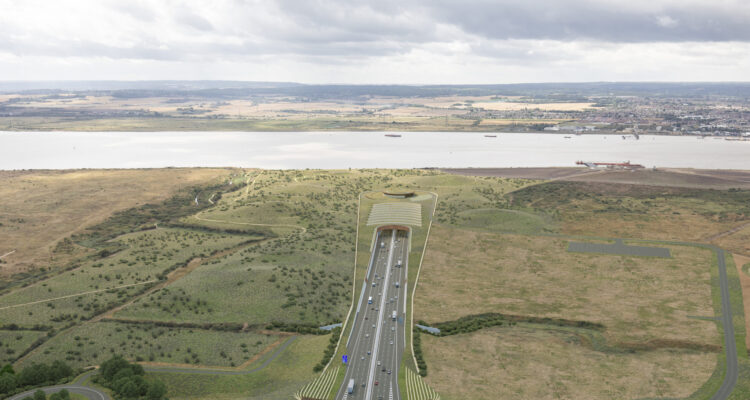On Tuesday 25th March 2025, the government has officially approved the A122 Lower Thames Crossing project, a significant infrastructure initiative designed to alleviate congestion at the Dartford Crossing and enhance connectivity between the South East, Midlands, and North. This development marks a pivotal advancement in the nation’s transportation network, promising substantial economic and environmental benefits.
The Lower Thames Crossing encompasses a 14.5-mile (23-kilometre) route, featuring a 2.6-mile (4.2-kilometre) twin-bore tunnel beneath the River Thames, connecting Kent and Essex. This tunnel will be the UK’s longest road tunnel to date. The project aims to nearly double road capacity across the Thames east of London, providing a critical alternative to the frequently congested Dartford Crossing.
The Dartford Crossing has long been a notorious bottleneck, handling traffic volumes far exceeding its intended capacity. The introduction of the Lower Thames Crossing is projected to reduce congestion by diverting approximately 13 million vehicles annually, thereby improving journey times and reliability for motorists and freight operators alike.
By enhancing connectivity between key economic regions, the project is expected to stimulate economic growth. Improved transport links will facilitate more efficient movement of goods and services, bolstering trade and supporting local businesses. National Highways estimates that the crossing will contribute £200 million annually to the economy by reducing congestion.
In alignment with the UK’s commitment to net-zero emissions by 2050, the Lower Thames Crossing project has integrated several environmentally conscious initiatives. Notably, it plans to utilise hydrogen-powered construction machinery, marking a significant step towards carbon-neutral construction practices. This approach not only reduces the project’s carbon footprint but also sets a precedent for future infrastructure developments.
Construction of the Lower Thames Crossing is due to commence between 2026 and early 2027, with completion anticipated by 2032. The project’s estimated cost has risen to £10 billion, reflecting its scale and complexity. Funding will be sourced through a combination of government expenditure and private investment, with discussions ongoing regarding the optimal financing model. One proposed approach is the regulated asset base model, which could attract approximately £6.3 billion in private investment, supplemented by nearly £2 billion in taxpayer funding.
Government and Business Support
The approval of the Lower Thames Crossing has been met with enthusiasm from various government officials and business leaders. Transport Secretary Heidi Alexander emphasised the project’s role in enhancing national connectivity and driving economic growth. Local MPs and business groups have also expressed support, highlighting the potential for job creation and improved transport efficiency.
Environmental and Community Concerns
Despite the anticipated benefits, the project has faced criticism from environmental campaigners and local communities. Concerns have been raised regarding potential increases in carbon emissions and the environmental impact of construction. Additionally, some residents fear that the new infrastructure may lead to increased traffic and disruption in their local areas. National Highways has committed to ongoing community engagement and implementing mitigation measures to address these concerns.
Matt Palmer, National Highways Executive Director Lower Thames Crossing, said: “The Lower Thames Crossing is one of the UK’s most important infrastructure projects. It will unlock growth with quicker, safer, and more reliable journeys and redraw the blueprint for building major projects in a net zero future by scaling up the use low-carbon construction and leaving a legacy of green spaces and green skills.
“Our plans have been shaped by the local community and refined by robust and rigorous examination from independent experts. We are more committed than ever to working with our neighbours to build the crossing in a way that offers them opportunities to work and learn new skills while reducing impacts. We are shovel ready and have our delivery partners on board, and today’s decision allows us to work with government on funding and start the detailed planning that will let us start construction as soon as possible.”
RHA MD Richard Smith, said: “I’m delighted to welcome the development consent decision on the Lower Thames Crossing. This critical infrastructure project has been a long-standing priority for the RHA. This is a major victory for the road transport sector and the wider economy. This nationally significant scheme has the potential to turbocharge the economy.
“The project will provide much-needed reliability for businesses. Delays at Dartford have decreased productivity and increased costs for businesses. The LTC will improve journey times and boost economic growth in the region. This is more than a local project however – this is a nationally significant scheme.
“After many years of delays in giving LTC the green light, this next step in the process will be a welcome relief to operators of lorries, coaches, and vans who must navigate the daily impact of delays.
“The Lower Thames Crossing offers value for money and will bring wider economic benefits across the country. It’s a big step forward in helping to drive forward the long-term economic growth the Government has pledged.”
The government’s approval of the Lower Thames Crossing represents a landmark decision in the UK’s infrastructure development. By addressing longstanding congestion issues and enhancing regional connectivity, the project is poised to deliver significant economic benefits. However, it is imperative that environmental and community considerations are carefully managed to ensure a balanced and sustainable outcome.


















